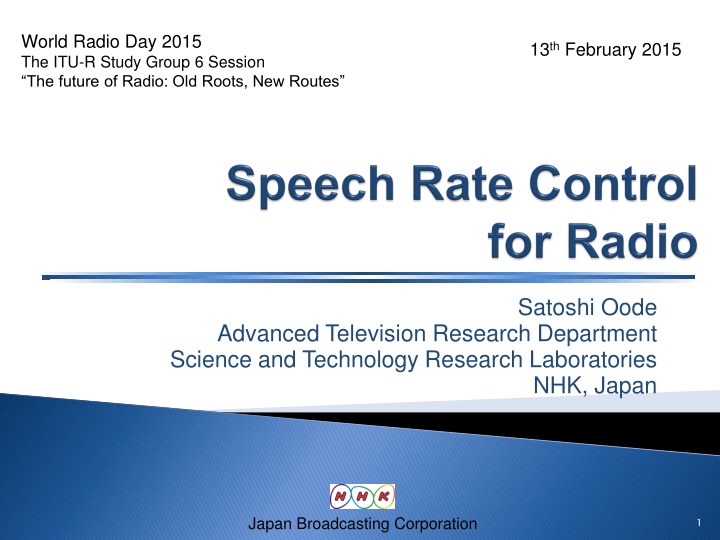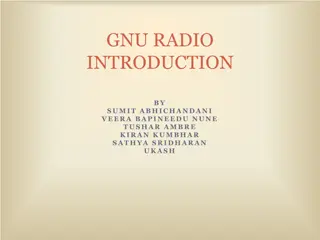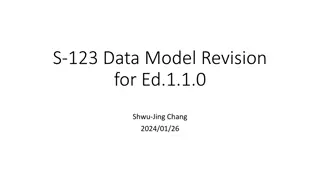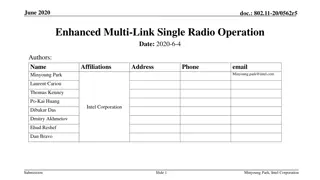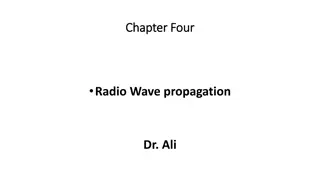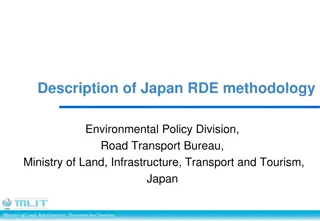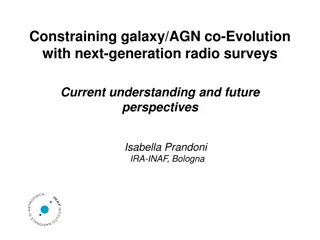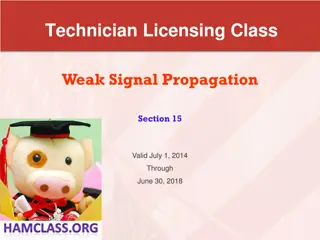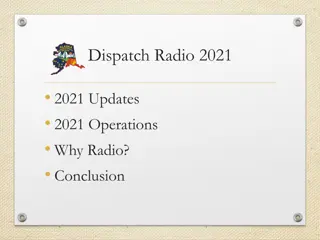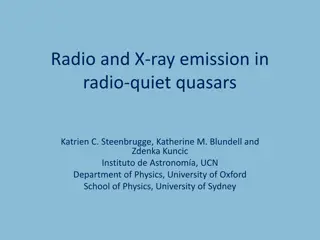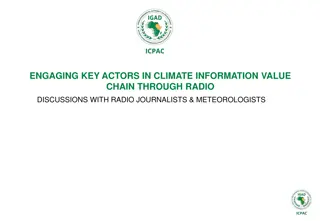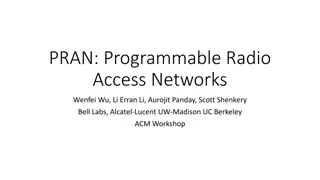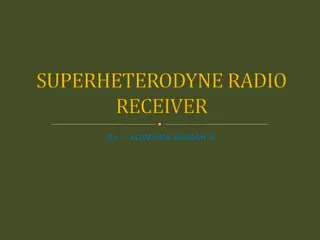Evolution of Radio Services: Japan's Technological Advancements
Radio service in Japan has a rich history dating back to 1925, with NHK continuously innovating to cater to different needs, including closed-captioning services for the hearing impaired and speech rate control technology for the elderly. As Japan faces challenges from its rapidly aging population, initiatives like live closed-captioning and speech synthesis technologies aim to enhance accessibility and inclusivity in radio broadcasting. Learn more about the advancements shaping the future of radio services in Japan.
Download Presentation

Please find below an Image/Link to download the presentation.
The content on the website is provided AS IS for your information and personal use only. It may not be sold, licensed, or shared on other websites without obtaining consent from the author.If you encounter any issues during the download, it is possible that the publisher has removed the file from their server.
You are allowed to download the files provided on this website for personal or commercial use, subject to the condition that they are used lawfully. All files are the property of their respective owners.
The content on the website is provided AS IS for your information and personal use only. It may not be sold, licensed, or shared on other websites without obtaining consent from the author.
E N D
Presentation Transcript
World Radio Day 2015 The ITU-R Study Group 6 Session The future of Radio: Old Roots, New Routes 13thFebruary 2015 Satoshi Oode Advanced Television Research Department Science and Technology Research Laboratories NHK, Japan Japan Broadcasting Corporation 1
Radio service in Japan started in 1925. NHK has been providing radio service using two AM channels and an FM channel since then. Until now, radio is one of the important media to get information, knowledge, fun and so on. Especially, radio made a vital contribution to survive in the disaster, for instance, the big earthquakes in 1995 (Kobe), 2011 (Tohoku). Broadcasters have a responsibility for transmitting their programs to listeners independently not only from regional difference but also from individual difference . However, TV and Radio Programs exclusively for the hearing or visually impaired people and the elderly are not so many. 2
For hearing impaired people NHK started off-line closed-captioning services in the 1980s, and on-line live closed-captioning services for News proguramme from 2000. Digital TV system has standard slots which are applicable to closed-captioning and audio description. Japan aims 100% of closed-caption including live programmes by the end of 2017 , excluding technically impossible programmes. On-line live closed-captions are automatically made using speech recognition technology. For the elderly and visually impaired people Speech rate control and speech synthesis technologies are being studied. On-line live closed-captions Speech Rate Control Technology is focused on not only by the elderly but also the foreign language leaner. 3
Aging society is progressing rapidly in Japan. 26 % of the population was elder than 65 in 2014. Their audibility gradually and certainly degrade due to aging. The elderly say; Newscaster speaks too fast and it s hard to understand . Dialogue of actor is hard to catch because of BGN or sound effects . What did he say? too fast.. Conventional hearing aid device It compensates for only elder s audible degradation related to the dynamics of loudness and frequency range. Speech rate control technology It was developed to make speech easier to listen to. It can maintain vocal pitch and quality. The length for a programme does not change, only the speech rate changes. 4
To keep the fundamental period, the speech rate control technology is based on expansion and contraction of waveform by insertion and deletion of fundamental periods. Fundamental period is not changed and vocal pitch and quality are maintained . Proposed method time Original Conventional method Fundamental period is enlarged or shorted and pitch becomes lower or higher. 5
Speech rate control was performed by two operational modes as follows: (i) Uniform extension of the utterance time. (ii) Adaptive mode giving slower feeling without accumulating time delay. It expands the beginning of the speech sufficiently and contracts the pauses between words or sentences as much as possible. This method minimizes the time delay of the slowed speech, without producing perceptual incongruities. Original Good morning everyone! Here in NHK. pause Delay is accumulated Uniformly extended G o o d m o r n i n g e v e r y o n e ! H e r e i n N H K . Pause is shorted with maintaining the naturalness Adaptive mode G o o d m o r n i n g e v e r yo n e ! H e r e in NHK. time Slowed at first and gradually restored Controlled speech is synchronized with original 6
Materials : 3 broadcast news sentences, about 10 seconds respectively Evaluation : Method of paired comparison; Which do you hear slower, original or Adaptive mode converted speech ? Result : 80% of 60s and 70s, and more than 50% of 80s+ heard Adaptive mode is slower than original . 70 (137 ) Aged 70 to 79 (N=137) 60 (92 ) Aged 60 to 69 (N=92) 80 (28/103) Aged 80 or more (N=50) 100% Evaluation ratio 80% 60% 40% 20% 60 (22/103) 0% (%) 100% 1 2 3 1 2 3 1 News Sentences Number 2 3 Original Adaptive mode Same 50% 7 7 0% 1 2 3
Radio receiver with Speech Rate Control function was manufactured by JVC in 2002. Its user-friendly interface was designed for the elderly. It has not only speech rate control function but also repeat play back and vocal enhancement function. After that, TV equipped with the speech rate control function was manufactured. Radio with Speech Rate control function manufactured by JVC in 2002. 8
Youve got a Pile of recorded programmes. Recorded programs can be played back faster. - Programs stacked in recorder can be watched in shorter time for business person. - Foreign languages can be made fast for experts to train. Let s skim through the programmes! Faster -The deletion of pitch periods can make total speech time shorter and maintain vocal pitch. time Original Slower - The adaptive mode*1 of speech rate controller will make speech still be comprehensible. *1 It expands the beginning of the speech sufficiently and removes the pauses. Proposed method Faster time Original Slower Conventional method 9
For leaner of foreign language Applicable to multiple languages We executed the adjustment to Japanese, English, German, and Korean of this technology in consideration of a acoustical feature of the utterance. Available on NHK s www NHK now offers an on-demand service to listen to the radio news that had been broadcast within 24 hours at the 3 speeds (slow -normal - fast) . For visually impaired people Upgrading the Speech Rate Control Technology by using the Metadata It identify places in recorded sound to adjust the listening experience, and it clues to catch the amazing fast speech. (e.g. 3 times normal speed) http://www.nhk.or.jp/r-news/ 10
Stock Market and Weather News are broadcasting using the speech synthesis technology on NHK s Radio 2. The technology can generate speech of any stock price to combine small vocal units of speech. The stock value is fifty four. is fifty-f fifteen-f ty-five ty-four en-four is-fi fifty-f ty-four Database Vocal units are combined In the Stock Market programe, closing prices of about 830 items are read out in 45 minutes. It is hard for announce to be exactly and to keep even temp. This task is matched for speech synthesis technology. Now, speech rate control technology is used to finish to read all items in just 45 minutes. 11
Technology is spreading now. Further research and development are necessary to improve accessibility especially for the elderly. Future Works News readout service in data broadcasting. The speech synthesis read out News flash through data broadcasting. Audio balance measurement algorithm. The device to indicate the suited balance between dialogue and background sound for the elderly are being developed considering the age-related hearing loss. Proto type of Audio balance meter Dialogue enhancement in 8K SHV broadcasting. The 8K Super Hi-Vision broadcasting plans to support to control the level of dialogue channels by the listeners. 12
